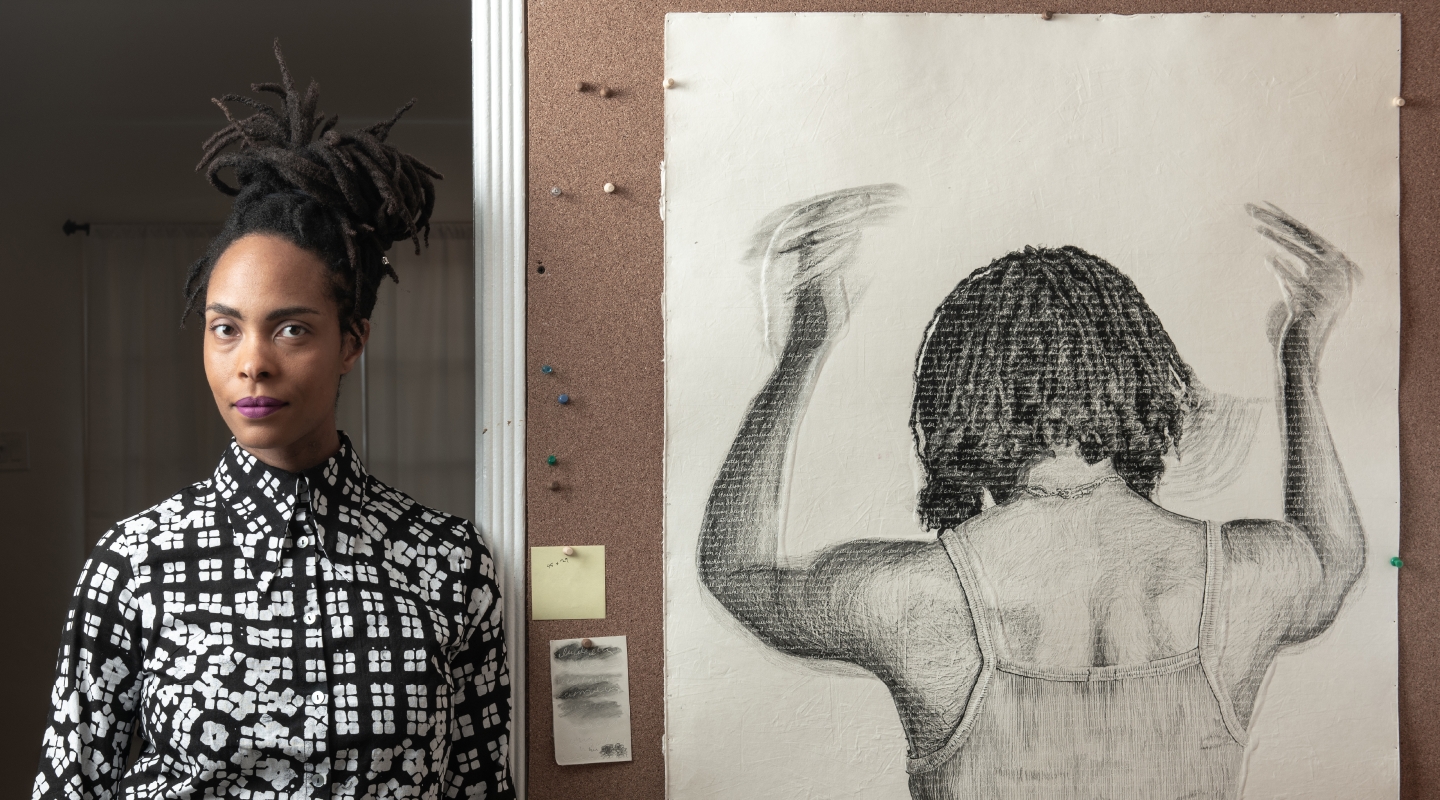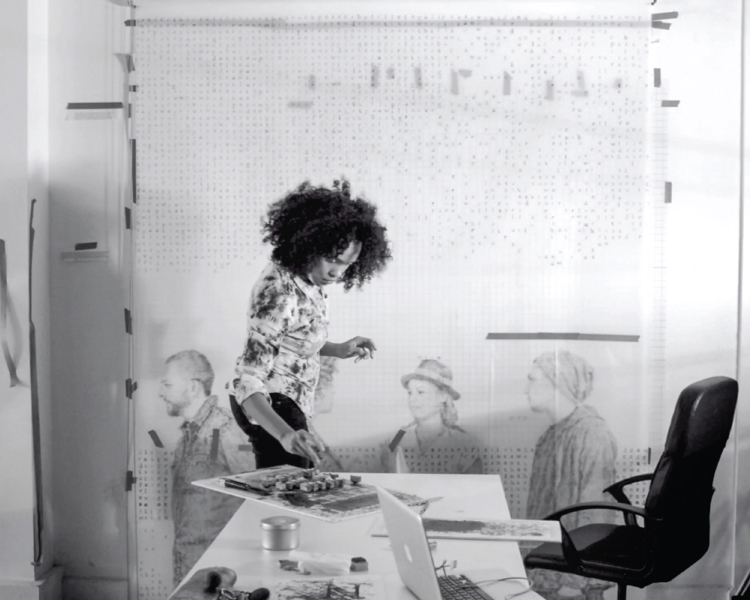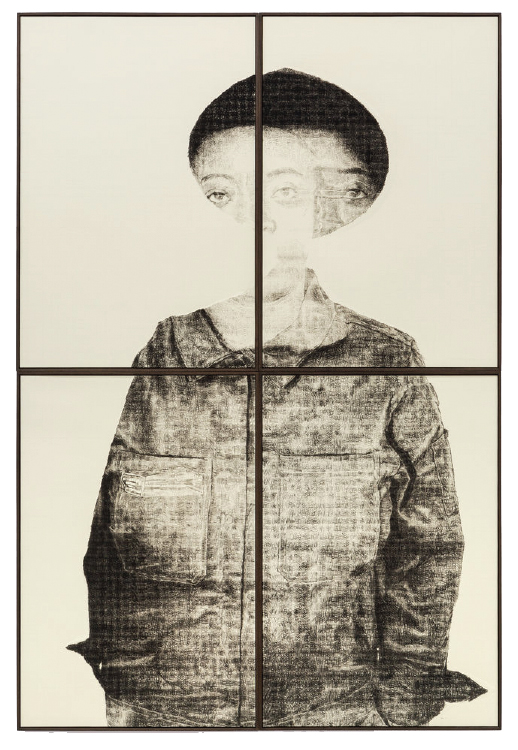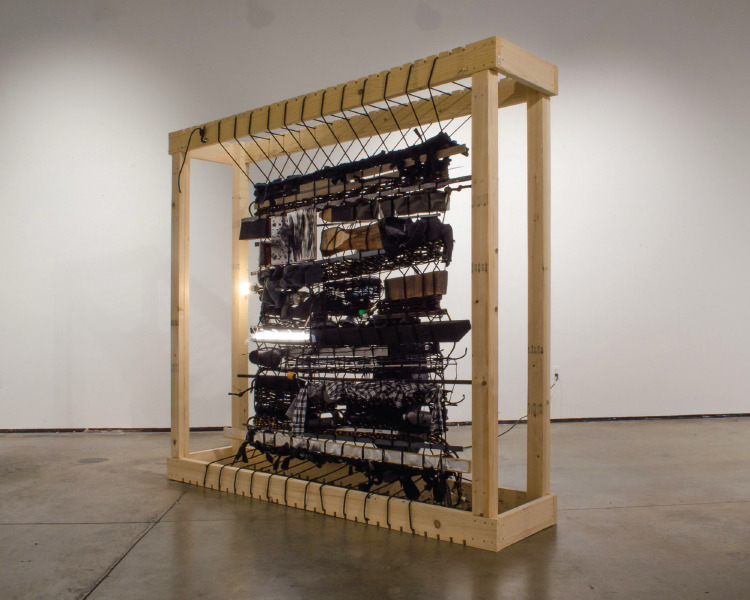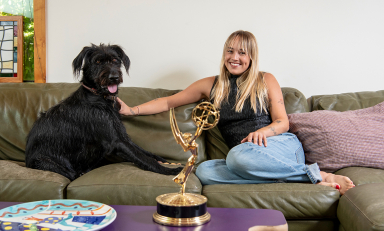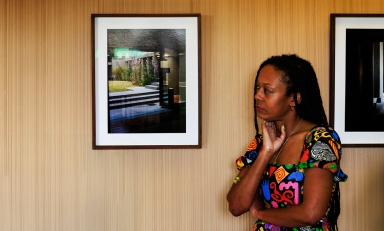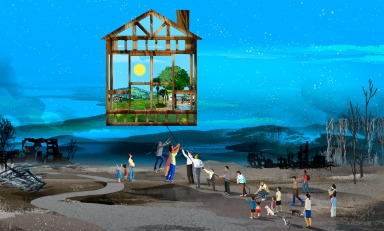Kenturah Davis '02 explores the relationship between words and humanity through her intricate portraiture—and L.A. Metro riders will be seeing a lot more of her work
“I can’t remember a time when I didn’t want to be an artist,” says Kenturah Davis ’02, sitting at the broad worktable dominating the reconfigured dining room of her Highland Park home and studio. But her journey to this point—and the evolution of her intricate, evocative work—has been long and circuitous.
Davis’ own current portraiture involves what she calls text drawings. “They’re works on paper made by handwriting texts in repetition,” she explains. “Others are made by using rubber stamp letters and stamping out a phrase in repetition to render the figure.“I like referring to them as drawings because that seems to be the most flexible category for me,” she adds, “thinking through the way we write, the way we experience written language on a page, and blurring the distinction between writing and drawing.”
She’s shown her work internationally, and returned to Oxy in 2018 as an adjunct assistant professor of art and art history. Later this year, 10 of her text-based portraits will be incorporated into the Downtown Inglewood station on the new Metro Crenshaw/LAX Line, on permanent display to urban riders.
The drawings she created for Metro are an extension from a series titled Sonder, which she exhibited at the Papillion Institute of Art in Los Angeles in 2013. The name comes from a project called the Dictionary of Obscure Sorrows, in which writer John Koenig “was inventing new words and these really poetic definitions for them,” Davis explains. “Sonder basically describes the experience of noticing strangers and being curious about what their lives are like.”
In putting together the project, Davis put out a call throughout Los Angeles for anyone with a connection to Inglewood to participate in a photo shoot. “What was beautiful was just watching people engaging or even not engaging but just people noticing strangers, people that they didn’t know,” she says.
Davis ended up using that word, sonder, to render the images. “Everything kind of clicked in a way,” she says, “because that is the kind of experience that you can have on a train or in public transportation.”
It can be hard to define the intricate, random bouillabaisse of influence that sparks a young person’s journey into a lifelong pursuit of art. In Davis’ case, it’s a delicate mixture of the subtleties of plein air water colors and the artistic set design nuances of Godzilla, Tron, and Star Trek.
“My dad, Keni Davis, was a set painter for movies and TV, and was in the union for over 30 years,” says Kenturah, who grew up in nearby Altadena. “He would take me and my sisters, Trenae and Tresell, out painting down by the Rose Bowl to show us how to draw in perspective. And my mom makes quilts and taught me how to sew, so there was that side too. I can’t imagine having better and more supportive parents.”
Witnessing her dad’s professional work, as well as his still-active plein air passion, “contributed to me thinking that being an artist was very practical as a career. I didn’t realize how challenging it was.”
Despite her innate drive toward art, it was volleyball that landed Davis at Occidental—at 5'9" she could jump high with serious hang time, and she played at Oxy for all four years. “My coach from high school, Jennifer Pullen ’98, had gone to Occidental and then at a tournament we met Linda Lyke,” says Davis. “She saw something in me early on.”
“Her team was playing my daughter’s team,” recalls Lyke, who has taught art and art history at Oxy since 1976. “I sat with [Kenturah’s] mother just coincidentally, and I said, ‘Where’s your daughter going to go to school? Why don’t you try Occidental? She’s a great volleyball player, and she would be a great student for Oxy and she’s interested in art, and I’d be happy to try to help her get in.’”
Prior to her freshman year in 1998, Davis was invited to participate in Oxy’s Multicultural Summer Institute. “I lived on campus, and that primed me for what college life would be like,” she says. Having graduated from John Muir High School in Pasadena, “It was really a step up in terms of thinking differently, more critically than high school. It was really valuable and just super rigorous.”
Davis, who graduated cum laude with a B.A. in visual arts and art history, took every printmaking class Lyke taught. “Kenturah was a standout, always, from 40 years of teaching,” says Lyke, who became a mentor to the budding creative. “There’s just a handful that you consider to be real artists. And she definitely had the drive, talent, and inclination of going deeper into her work in terms of trying to have a clear voice of what she wanted to do.”
Occidental’s liberal arts program had the broadening impact Davis was hoping for: “I was thinking about ideas beyond just painting and drawing or whatever I was interested in doing visually.” She ended up minoring in anthropology, and then-associate professor Elizabeth Chen “played a big role in opening my mind to other fields, and how these disciplines can overlap,” Davis adds. “I started to think about language and linguistics and how they operate in our lives. It had a huge influence later in my work.”
After graduating from Oxy, Davis found herself “struggling” to make a living as an artist,” so she moved to Washington, D.C., where she found work in a gallery and bookstore. “I was painting but grew frustrated with the kind of paintings I was making. I stopped making art for about two years, and spent that time doing a lot of reading and writing. I eventually found that I was interested in our relationship with language and working through how I might address those ideas visually.”
In 2004, Davis came back to Los Angeles, still maneuvering the tricky worlds of making art and survival. She took a job in West Hollywood as a receptionist at Gemini GEL (Graphic Editions Limited), an artists’ workshop and publisher. Davis stayed there for nine years, eventually rising to director of sales, putting in 40 hours a week while creating into the wee hours at her Highland Park studio.
“The beautiful thing about that job was meeting artists that I’d only read about in history books and seen in museums,” she says. “They came to the studio, and you got to witness them start a project and see it through from beginning to end. Eventually it got to the point where I was showing, and then to where I thought I could leave that job and keep working on my own.”
A clothing designer friend invited her to move to Accra, the capital of Ghana, to manage production—a six-month gig that turned into a year and a half. “The first thing that hit me when I got off the plane was that Accra has a distinct warm smell to it,” recalls Davis, who still goes back annually. “It immediately felt like another home. It’s so vibrant. You’re going through the streets passing by goats and cows, but it’s also very metropolitan. I quickly fell in love with it.”
Soon after her return from Accra, Davis enrolled at the Yale School of Art. Toward the end of Davis’ productive two-year stint in New Haven, L.A. art dealer Matthew Brown contacted her. He’d seen her last local show in 2014 at a gallery in Leimert Park in South Los Angeles and was planning to open his own space. Brown visited her at Yale, asking her to create work that would serve as his inaugural exhibition.
“I was immediately blown away by how intricate her works were,” Brown says. “The more I learned about her process the more impressed I was. It was a dream to be able to open the gallery with Kenturah.”
Davis’ show, Blur in the Interest of Precision, debuted in January 2019. “She represents everything I would want the gallery to be aligned with, both as an artist and a human being,” Brown says. “I will always be indebted to her for taking such a risk on me.”
Brown’s gallery show and surgery on Lyke’s knee became the catalysts for Davis not only returning to her hometown but to Occidental. “I had a medical procedure,” says Lyke, “so we needed an adjunct to teach the printmaking classes. I asked Kenturah if she would teach for us, and the department was delighted because they all knew her from her days as an undergraduate. She was already experienced as an artist in L.A., so it was great.”
“Linda having the confidence in me to take that on felt too good to pass up,” Davis says. “It was a great chance for me to think about the kind of teacher I wanted to be, and working that out was valuable to me as a maker of art.
“The teachers I learned from the most were people who realized that—while they had a lot to offer their students—they didn’t know everything, and their students could have something to offer to them,” Davis continues. “It was like the classrooms were a space to experiment together. That’s the kind of thing I tried to create in the two printmaking classes that I’ve taught.”
There’s not a lot of furniture in Davis’ living room, but there is an intricate scale model of the SCAD Museum of Art, part of the Savannah College of Art and Design in Georgia. Looking down into the roofless, maze-like mockup, there are small pieces of art on the foam core walls. It could be a high-end gallery for erudite mice.
“I’ve got my first solo museum show coming up there,” says Davis of her Feb. 6 exhibition at SCAD’s Walter O. Evans Center for African American Studies. “It’s about 3,000 square feet. I worked with the curator to design the setup and what would go where.” But, as he was decades ago, her father continues to be in the picture. “Oh yeah, he still helps me sometimes,” she says. “My dad actually built this model for me.”Next spring, Davis will be back teaching printmaking at Oxy, something she wants to continue. But, as the demand for her art increases, it makes for a full dance card.
“Right now I’m trying to figure out what that balance is like,” she says. “I don’t know how Linda [Lyke] and all the other fantastic faculty that I’ve had teach full-time and make art. I love it so much, but it’s tough sometimes keeping up with the deadlines these days. But that’s a good problem to have.”
Gilstrap wrote “’23 and Me” last issue.

